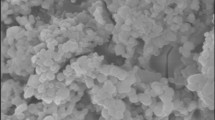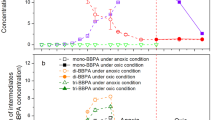Abstract
The degradation of hexachlorobenzene (HCB) is of great concern and attracts considerable scientific and regulatory interests, due to the high toxicity, great bioaccumulation, and persistence of HCB in the environment. However, in the real HCB-contaminated soil, the effect of coexisting chlorobenzene congeners on the degradation capacity of HCB is poorly known. In this work, the anaerobic degradation behaviors of three coexisting chlorobenzene congeners pentachlorobenzene (PeCB), 1,2,4,5-tetrachlorobenzene (1,2,4,5-TeCB), and 1,2,4-trichlorobenzene (1,2,4-TCB) and the influence of initial pH and reaction temperature on the dechlorination of HCB in HCB-contaminated soil from the dye plant were studied. The amount and extent of accumulated coexisting chlorobenzenes was analyzed under different environmental conditions. The results indicate that the concentrations of three coexisting chlorobenzene congeners change in the form of wave. The anaerobic degradation activity of HCB is reduced due to the feedback inhibition caused by accumulation of coexisting chlorobenzene congeners, and the feedback inhibition varies from environmental conditions.







Similar content being viewed by others
References
Adrian, L., & Görisch, H. (2002). Microbial transformation of chlorinated benzenes under anaerobic conditions. Research in Microbiology, 153, 131–137.
Bailey, R. E. (2001). Global hexachlorobenzene emissions. Chemosphere, 43, 167–182.
Barber, J. L., Sweetman, A. J., Wijk, D. V., & Jones, K. C. (2005). Hexachlorobenzene in the global environment: emissions, levels, distribution, trends and processes. Science of the Total Environment, 349, 1–44.
Brahushi, F., Dörfler, U., Schroll, R., & Munch, J. C. (2004). Stimulation of reductive dechlorination of hexachlorobenzene in soil by inducing the native microbial activity. Chemosphere, 55, 1477–1484.
Chang, B. V., Chen, Y. M., Yuan, S. Y., & Wang, Y. S. (1997). Reductive dechlorination of hexachlorobenzene by an anaerobic mixed culture. Water, air, and soil pollution, 100, 25–32.
Chen, I. M., Wanitchapichat, W., Jirakittayakorn, T., Sanohniti, S., Sudjarid, W., Wantawin, C., Voranisarakul, J., & Anotai, J. (2010). Hexachlorobenzene dechlorination by indigenous sediment microorganisms. Journal of Hazardous Materials, 177, 244–250.
Fathepure, B. Z., Tiedje, J. M., & Boyd, S. A. (1988). Reductive dechlorination of hexachlorobenzene to tri- and dichlorobenzene in anaerobic sewage sludge. Applied Environmental Microbol, 54, 327–330.
Hippelein, M., & McLachlan, M. S. (1998). Soil/air partitioning of semivolatile organic compounds: 1. Method development and influence of physical-chemical properties. Environmental Science and Technology, 32, 310–316.
Hirano, T., Ishida, T., Oh, K., & Sudo, R. (2007). Biodegradation of chlordane and hexachlorobenzenes in river sediment. Chemosphere, 67, 428–434.
Huang, H., Jiang, J. G., Xiao, Y., Chen, X. J., & Liu, S. (2014). A novel and efficient method for dechlorination of hexachlorobenzene using a sodium carbonate/glycerol system. Chemical Engineering Journal, 256, 205–214.
Liu, C. Y., Jiang, X., Wang, F., Yang, X. L., & Wang, T. (2010a). Hexachlorobenzene dechlorination as affected by nitrogen application in acidic paddy soil. Journal of Hazardous Materials, 179, 709–714.
Liu, C. Y., Jiang, X., Yang, X. L., & Song, Y. (2010b). Hexachlorobenzene dechlorination as affected by organic fertilizer and urea applications in two rice planted paddy soils in a pot experiment. Sci Total Environment, 408, 958–964.
Matheus, D. R., Bononi, V. L. R., & Machado, K. M. G. (2000). Biodegradation of hexachlorobenzene by basidiomycetes in soil contaminated with industrial residues. World Journal Microbiol Biotechnol, 16, 415–421.
Meijer, S. N., Ockenden, W. A., Sweetman, A., Breivik, K., Grimalt, J. O., & Jones, K. C. (2003). Global distribution and budget of PCBs and HCB in background surface soils: implications for sources and environmental processes. Environmental Science and Technology, 37, 667–672.
Oonnittan, A., Shrestha, R. A., & Mika, S. (2009a). Removal of hexachlorobenzene from soil by electrokinetically enhanced chemical oxidation. Journal of Hazardous Materials, 162, 989–993.
Oonnittan, A., Shrestha, R. A., & Sillanpää, M. (2009b). Effect of cyclodextrin on the remediation of hexachlorobenzene in soil by electrokinetic Fenton process. Separation and Purification Technology, 64, 314–320.
Rousk, J., Brookes, P. C., & Bååth, E. (2009). Contrasting soil pH effects on fungal and bacterial growth suggest functional redundancy in carbon mineralization. Applied and Environmental Microbiology, 75, 1589–1596.
Rousk, J., Brookes, P. C., & Bååth, E. (2010). Investigating the mechanisms for the opposing pH relationships of fungal and bacterial growth in soil. Soil Biology and Biochemistry, 42, 926–934.
Shih, Y. H., Hsu, C. Y., & Su, Y. F. (2011). Reduction of hexachlorobenzene by nanoscale zero-valent iron: kinetics, pH effect, and degradation mechanism. Separation and Purification Technology, 76, 268–274.
Sweetman, A. J., Valle, M. D., Prevedouros, K., & Jones, K. C. (2005). The role of soil organic carbon in the global cycling of persistent organic pollutants (POPs): interpreting and modelling field data. Chemosphere, 60, 959–972.
Takaqi, K., Iwasaki, A., Kamei, I., Satsuma, K., Yoshioka, Y., & Harada, N. (2009). Aerobic mineralization of hexachlorobenzene by newly isolated pentachloronitrobenzene-degrading Nocardioides sp. strain PD653. Appl. Environ Microbiology, 75, 4452–4458.
USEPA. (2007). Method 8270D: semivolatile organic compounds by gas chromatography/mass spectrometry (GC/MS). Washington, DC: US Environmental Protection Agency.
Wu, Q. Z., Milliken, C. E., Meier, G. P., Watts, J. E. M., Sowers, K. R., & May, H. D. (2002). Dechlorination of chlorobenzenes by a culture containing bacterium DF-1, a PCB dechlorinating microorganism. Environmental Science and Technology, 36, 3290–3294.
Yuan, S. Y., Su, C. J., & Chang, B. V. (1999). Microbial dechlorination of hexachlorobenzene in anaerobic sewage sludge. Chemosphere, 38, 1015–1023.
Yuan, S. H., Tian, M., & Lu, X. H. (2006a). Electrokinetic movement of hexachlorobenzene in clayed soils enhanced by Tween 80 and β-cyclodextrin. Journal of Hazardous Materials B, 137, 1218–1225.
Yuan, S. H., Tian, M., & Lu, X. H. (2006b). Microwave remediation of soil contaminated with hexachlorobenzene. Journal of Hazardous Materials B, 137, 878–885.
Zhou, D. Q. (2002). Text book of microbiology. Beijing: Higher Education Press.
Author information
Authors and Affiliations
Corresponding author
Rights and permissions
About this article
Cite this article
Jiang, L., Wang, Q., Liu, H. et al. Influence of Degradation Behavior of Coexisting Chlorobenzene Congeners Pentachlorobenzene, 1,2,4,5-Tetrachlorobenzene, and 1,2,4-Trichlorobenzene on the Anaerobic Reductive Dechlorination of Hexachlorobenzene in Dye Plant Contaminated Soil. Water Air Soil Pollut 226, 299 (2015). https://doi.org/10.1007/s11270-015-2559-3
Received:
Accepted:
Published:
DOI: https://doi.org/10.1007/s11270-015-2559-3




